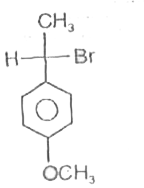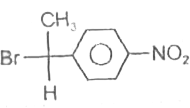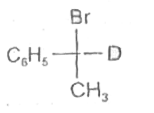udner identical conditions, solvolysis of which of the following substrate would lead to maximum racemisation?




The correct Answer is:B
To determine which substrate would lead to maximum racemization during solvolysis, we need to analyze the stability of the carbocations formed from each substrate. The more stable the carbocation, the greater the extent of racemization, as it allows for nucleophilic attack from both sides of the planar carbocation intermediate.
1. Understanding Racemization:
- Racemization refers to the formation of a racemic mixture, which contains equal amounts of enantiomers (dextrorotatory and levorotatory compounds). This typically occurs in reactions that proceed through an SN1 mechanism, where a carbocation intermediate is formed.
Hint: Recall that racemization occurs when a reaction can lead to the formation of two different stereoisomers from a single precursor.
2. Recognizing the SN1 Mechanism:
- The SN1 mechanism involves the formation of a carbocation, which is a positively charged species. The stability of this carbocation is crucial as it influences the extent of racemization.
Hint: Remember that in an SN1 reaction, the nucleophile can attack from either side of the planar carbocation, leading to racemization.
3. Evaluating Carbocation Stability:
- The stability of carbocations is influenced by factors such as inductive effects (I) and resonance effects (R). More stable carbocations lead to greater racemization.
- We will analyze the carbocation formed from each option based on these effects.
4. Analyzing Each Option:
- Option 1: The carbocation formed is stabilized by the +I effect of a methyl group. This provides some stability but is limited.
- Option 2: The carbocation here is stabilized by resonance from the benzene ring and the +I effect from the methyl group and the OCH3 group. This provides maximum stabilization.
- Option 3: The carbocation is destabilized by the presence of an electron-withdrawing NO2 group, which decreases its stability.
- Option 4: The carbocation is stabilized by resonance from the benzene ring and the +I effect from the methyl group, but not as effectively as in Option 2.
Hint: Compare the number and type of stabilizing effects for each carbocation to determine which one is the most stable.
5. Conclusion:
- After evaluating the stability of the carbocations formed from each substrate, we find that the carbocation in Option 2 is the most stable due to the combination of resonance and inductive effects. Therefore, it will lead to the maximum racemization.
Final Answer: The substrate that would lead to maximum racemization under identical conditions is Option 2.
- Racemization refers to the formation of a racemic mixture, which contains equal amounts of enantiomers (dextrorotatory and levorotatory compounds). This typically occurs in reactions that proceed through an SN1 mechanism, where a carbocation intermediate is formed.
- The SN1 mechanism involves the formation of a carbocation, which is a positively charged species. The stability of this carbocation is crucial as it influences the extent of racemization.
- The stability of carbocations is influenced by factors such as inductive effects (I) and resonance effects (R). More stable carbocations lead to greater racemization.
- We will analyze the carbocation formed from each option based on these effects.
- Option 1: The carbocation formed is stabilized by the +I effect of a methyl group. This provides some stability but is limited.
- Option 2: The carbocation here is stabilized by resonance from the benzene ring and the +I effect from the methyl group and the OCH3 group. This provides maximum stabilization.
- Option 3: The carbocation is destabilized by the presence of an electron-withdrawing NO2 group, which decreases its stability.
- Option 4: The carbocation is stabilized by resonance from the benzene ring and the +I effect from the methyl group, but not as effectively as in Option 2.
- After evaluating the stability of the carbocations formed from each substrate, we find that the carbocation in Option 2 is the most stable due to the combination of resonance and inductive effects. Therefore, it will lead to the maximum racemization.
Topper's Solved these Questions
- HALOALKANES AND HALOARENES BOOK - AAKASH INSTITUTE ENGLISHCHAPTER - HALOALKANES AND HALOARENES EXERCISE - ASSIGNMENT SECTION - C
39 Videos
- HALOALKANES AND HALOARENES BOOK - AAKASH INSTITUTE ENGLISHCHAPTER - HALOALKANES AND HALOARENES EXERCISE - ASSIGNMENT SECTION -D
15 Videos
- HALOALKANES AND HALOARENES BOOK - AAKASH INSTITUTE ENGLISHCHAPTER - HALOALKANES AND HALOARENES EXERCISE - ASSIGNMENT SECTON - A
45 Videos
- GENERAL PRINCIPLES AND PROCESSES OF ISOLATION OF ELEMENTSBOOK - AAKASH INSTITUTE ENGLISHCHAPTER - GENERAL PRINCIPLES AND PROCESSES OF ISOLATION OF ELEMENTSEXERCISE - Try Yourself
33 Videos
- HYDROCARBONSBOOK - AAKASH INSTITUTE ENGLISHCHAPTER - HYDROCARBONSEXERCISE - Assignment(Section - C) (Previous Years Questions)
60 Videos
Similar Questions
Knowledge Check
Which of the following is the conditional p→q is
Aq is sufficient for pBp is necessary for qCif p then qDIf q then p
Which of the following substrates will gave racemised product?
View SolutionWhich of the following is not an ore of lead?
View Solutionwhich of the following leads to redox reaction ?
View SolutionWhich of the following will not lead to a diuresis?
View SolutionWhich of the following would exert maximum osmotic pressure?
View SolutionWhich of the following leads to bonding?
View SolutionWhich of the following leads to bonding?
View Solution
